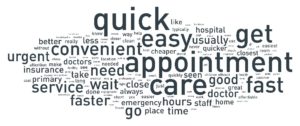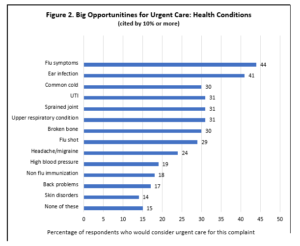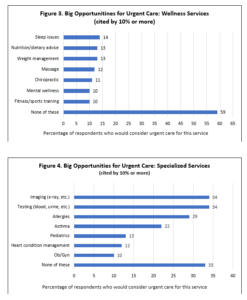Urgent message: Younger consumers’ healthcare preferences are significantly different than that of older consumers. Urgent care providers have a prime opportunity to meet the needs of Gen Z and Millennials by creating a new healthcare experience.
Dan Stanek
Introduction
As everyday healthcare begins to deviate from the classic primary care model, the competition is just beginning in regard to which alternative provider will best suit consumers’ needs. Urgent care may be the current provider type with the biggest opportunity. While the term “urgent” tends to make new and potential consumers believe they can only visit urgent care providers if they have a critical issue (similar to an emergency department), many urgent care centers offer services comparable to a PCP and can often do so without an appointment. Consumers, especially young and healthy ones, are taking notice and causing healthcare professionals to question their current model as the desire for convenient, cost-efficient care is expanding.
With this in mind, the consulting firm WD Partners undertook research into considerations healthcare decision makers take into account when making everyday decisions.
| Cohort Definitions
For this study, WD Partners divided consumers into the following cohorts: |
|
| Cohort | Age in 2019 (years) |
| Gen Z | 18–22 |
| Millennials | 23–38 |
| Gen X | 39–54 |
| Baby Boomers | 55–73 |
| Silent Gen | Over 73 |
Purpose
We start with the presumption that healthcare systems will continue to move away from monolithic hospital settings in an attempt to become more convenient for their customers. As healthcare moves closer to where people work and live and creates more consumer-friendly settings, this is an opportune time to learn the preferences of healthcare decision makers when it comes to everyday care.
The WD Partners’ study, Healthcare: Who Survives? found clear indications that consumers, especially Gen Z and Millennials, are increasingly looking to move away from the PCP’s office and toward more accessible, low-cost options. This movement is prominent among the factors that have prompted the everyday healthcare landscape to reconfigure, generating two new alternatives that better suit the public’s evolving needs: retail clinics and urgent care facilities. These new facilities are offering a more accessible approach to care, especially today as the number of available PCPs dwindles. The industry has long positioned PCPs as the gatekeeper for medical treatment, but with urgent care on the rise as a prominent player in the healthcare game, the results of WD Partners’ recent research indicate that this on-demand service is gaining traction in the industry, with tremendous opportunity for growth.
Population
In order to get a clear picture of the public’s healthcare preferences, we conducted an online survey of 2,600 consumers between 18 and 80 years of age regarding their opinions and usage of three different healthcare providers: PCPs, retail clinics, and urgent care facilities. These consumers received healthcare services from at least one of those providers in the past 6 months; for purpose of this survey, healthcare services refers to the medical care for the routine maintenance or improvement of health via the prevention, diagnosis, and treatment of disease, injury, and other physical illnesses. All respondents were the primary healthcare decision makers for themselves, their children, or their spouses, and were segmented by Gen Z, Millennials, Gen X, Baby Boomers, and Silent Generation.
After evaluating the survey’s results, it is clear that preferences are changing. In particular, we find that despite consumers’ longstanding and continual loyalty to PCPs, urgent care centers are quickly becoming a highly preferred alternative. Overall, 42% of consumers considered an urgent care facility for healthcare services in the past 6 months, while 85% considered a PCP. Considering how many facilities in each category are open–246,000 for primary care, according to the Agency for Healthcare Research and Quality, and anywhere from 8,774 to 13,000+ for urgent care, according to various sources, it shows that urgent care is proportionately strong.
Our research reveals that in the past 6 months, 28% of all consumers have used an urgent care center (compared to 12% who used retail clinics), with 37% being repeat visitors who made three or more visits. Overall, consumers find urgent care facilities to be quick, easy places to get appointments and care (Figure 1). When thinking about their most recent visits to these facilities, respondents said they chose this option because of:
- Convenient location (44%)
- Walk-in appointment availability (43%)
- Insurance coverage (43%)
They rated their visits to these facilities similarly, with the following being their most valued features:
- Convenience (70%)
- Insurance coverage (69%)
- Available appointments (68%)

Figure 1.
Age Comparison
Diving into these data further, a significant pattern emerges among the three healthcare service platforms by age. The changing of the guard from PCP to urgent care really jumps off the datasheet when comparing preferred healthcare platform among generations.
We looked at urgent care compared with other healthcare providers in three ways: consideration, usage, and preference. Half of our Millennial respondents considered urgent care, while only around 30% of Baby Boomers and the Silent Generation did the same.
Similarly, Gen Z and Millennial consumers use urgent care more widely, with around 36% reporting having used an urgent care in the past 6 months, compared with 19% of Boomers and members of the Silent Generation. Gen Z and Millennials frequented urgent care more than three times in the past 12 months at a much higher rate (56% and 45%, respectively) than Boomers and Silent Gen (26% and 22%).
Lastly, when it comes to preference, overall numbers clearly favor PCPs at 77%, but a deeper dive shows only 47% of Gen Z prefer PCP, whereas 90% of Boomers prefer PCP. It is obvious that the older generations are the ones driving those percentages up.
These disparities in urgent care utilization ultimately lead us to conclude that for younger generations, urgent care providers are essentially becoming their version of the PCP. Only 11% of our respondents overall claimed that urgent care centers were their most frequent provider; however, that number jumped to 21% for members of Gen Z, while the number fell to around 5% for both of the older generations.
The younger the consumer, the less likely they are to have established a PCP.
In the case of older consumers, familiarity breeds loyalty. Baby Boomers and the Silent Generation value longtime PCP loyalty, and for good reason: they have more complicated medical histories and typically need more extensive care. Gen Z and Millennials, on the other hand, look to convenience, speed, and ease of access, all of which are characteristics attributed to urgent care facilities.
Roughly 80% of Boomers and Silent Generation consumers reported being happy with their healthcare, while only 54% of Gen Z respondents shared their affection. This explains why younger respondents’ net promoter scores for PCPs are so low when compared with older consumers—which means they are more likely to use (and recommend) other providers. Evidently, these younger demographics are increasingly dissatisfied with primary care, and have no issue with looking for the alternative that will meet their needs. Enter urgent care facilities.
What Are the Opportunities?
Based on our findings, there are three big opportunities for urgent care facilities:
- Expand services. Respondents reported that they would consider urgent care facilities for a variety of services. The most common reasons consumers claimed that they would consider this provider for add-on care were for the treatment of health conditions like flu symptoms (44%) and ear infections (41%). For specialized services, the top add-ons are imaging and testing (34%). The most popular wellness service that they would consider at urgent care were for the treatment of sleep issues (14%), but overall, 59% of respondents reported that they would not consider an urgent care facility for their wellness needs. The interesting story related to wellness needs started when we looked at sleep issues by age. Looking at Gen Z, 23% would consider urgent care for sleep issues compared to only 8% of Baby Boomers. When it comes to specialty care, 39% of Gen Z would consider urgent care for Allergy treatment compared to only 25% of Boomers. This creates an opportunity for urgent cares to establish a value proposition that reinforces the perception of trust, quality and professional competence in order to show that they are capable of providing significantly more types of care. (See Figures 2, 3, and 4.)
- Reverse negatives. Urgent care providers are seen as strong in quality when it comes to grading them against their PCP counterparts, but lack in the familiarity department; the most common reason consumers reported not visiting these facilities is because they are not familiar with their working healthcare professionals. Unfamiliarity was the top reason that Boomers (44%) and members of the Silent Generation (50%) reported not considering urgent care facilities for services. This factor is still important to younger consumers, but far less than their older counterparts; only 8% of Gen Z and 20% of Millennials’ cited this as an urgent care deterrent. Seeking more ways to develop relationships and tie in EHR (electronic health records) will help foster the sense of familiarity offered by PCPs. The current market is saturated with independent urgent care centers that aren’t widely trusted by consumers due to their lack of brand recognition. Adding more urgent care locations in health system/PCP environments can counteract this element by using their established brand name to prove that they are a trustworthy care source.
The second and third most cited reasons for not visiting urgent care facilities were the service prices and extended time spent in waiting rooms. 28% of Gen Z respondents said that they didn’t consider an urgent care because of wait times in treatment rooms, and their second most cited reason was because of long waiting room times (as compared to 5% of Boomers). 28% of Millennial’s top reason for not considering urgent care facilities was because of high costs, which starkly contrasts the 5% of Silent Generation consumers who said the same. Younger generations appreciate shortened wait times and more price-conscious care, so improving those areas will prompt increased popularity among this group of consumers.
- Focus on younger demographics. Our research shows that younger healthcare consumers are seeking a replacement for the traditional PCP model. Urgent care or the next generation of urgent care centers can become that go-to provider, if they truly develop an offering that capitalizes on Gen Z’s and Millennials’ distinct preferences.
It doesn’t hurt that improvements in the areas of quality, familiarity, and cost will appeal to all generations and position them as the go-to provider of younger generations (because, let’s face it: as the population of older patients who are established with PCPs begins to die, the proportion of convenience-driven, younger consumers will replace their numbers). To be sustainable, a healthcare service must capture new customers and develop relationships with them that are satisfied and loyal. The best way to do this is to hold the attention of those using them most (Millennials and Gen Z) and place a direct focus on getting them to become repeat visitors. Urgent care facilities have the ability to meet that criteria, so long as they continue to grow, evolve, and offer consumers more clarity on exactly the types of services they can provide.


What’s Next? Threats to Consider
Urgent care facilities need to establish and, potentially, rebrand themselves as the on-demand PCP. One way would be to move away from the term “urgent,” which places the industry conceptually near an emergency department. This “identity crisis” could be detrimental to the provider’s growth; rather, showing consumers that urgent care is the best one-stop-shop for all their drop-in healthcare needs will increase their usage. Urgent care facilities have a great deal of potential to build on their “middle ground”—that is, they are perceived as providing convenience and efficiency without as much of the quality-of-care sacrifice that is currently hurting the reputation of retail clinics. The key, however, is to build on that middle ground and become a leader by providing a clear offering and improving quality-of-care perception.
Considering all of this, we know that urgent care facilities have a strong base setting them up for success. But they may be facing some competition when it comes to younger consumers; telemedicine is rising in popularity and could become urgent care’s biggest threat. Conversely, though it has been slow to catch on, some urgent care operators are starting to be successful by offering telemedicine as one of their services. Fact: 31% of all survey respondents claimed that if they could avoid going to the doctor’s office and complete their visits using technology, they would. And that percentage rises even higher for Gen Z (40%) and Millennials (42%), while it plummets for Boomers (15%) and the Silent Generation (9%). The number of consumers favoring this option will only continue to climb as telemedicine begins to improve.
In our consumer-driven marketplace, we must recognize a significant opportunity to make seismic changes in an industry. Today’s young healthcare decision makers have spoken. It’s time for healthcare providers to adapt to their needs in order to lead the industry into the future.
About WD Partners
WD Partners is a consulting firm that advises its clients on strategy, design, operations, architecture, engineering, and construction services with the intent of driving and shaping the customer experience. While those experiences include numerous retail and consumer brands, the company has also begun focusing more on consumer-driven practices in a health and wellness industry that is transitioning to consumerism.

